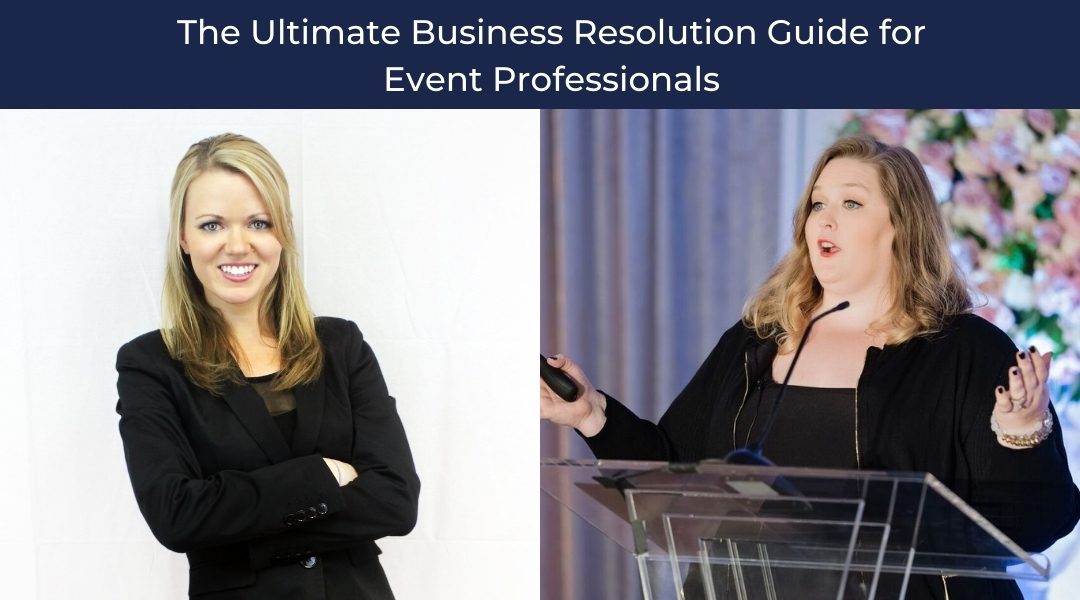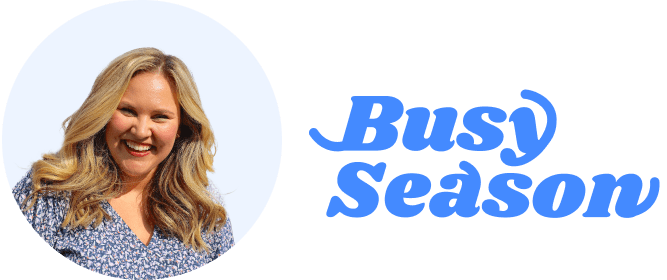2020 has started and it’s time for event pros to ensure they’re making headway on their New Year’s resolutions! Karen Gordon of Goodshuffle Pro and Kellie Daab of Wedding Industry Institute put together a business resolution guide via webinar full of insightful information, actionable tasks, and helpful resources that detail all the important business resolutions event pros should be making to grow their business and ensure success. In case you missed the webinar, here’s a recap!
Marketing and Sales
1) Event pros: Ask yourself what was working, what was not, and determine your KPIs.
Look at all aspects:
- Which social media posts get lots of (or few) engagements?
- Which emails have high (or low) open and click-through rates?
- What trade shows were successful (or unsuccessful) in terms of conversions?
- What inventory do you have that is (or isn’t) being rented often?
- Which events have high (or low) ROI?
Then determine your Key Performance Indicators. Your KPIs should be:
- Specific, measurable, and quantifiable
- Based on your particular strengths
- Based on your BIG goal
For instance, you may want to see at least 20 click-throughs from your Instagram each month. Or perhaps you want to get 30 people per trade show to give their emails in hopes of selling them on your brand. Whatever your KPIs are, make sure they fit into your big goal.
2) Create a list of your best and worst events and hammer out your sales process.
When measuring the success of your events, make sure you look at more than just your favorite clients, the biggest names, or the coolest visuals. Your best event may not be your highest-grossing one either! While high-netting events and popular names are important, the time vs. revenue factor and ancillary benefits also play a role in measuring success.
For instance, maybe it wasn’t your most profitable event, but you got beautiful photos or some really great online reviews from it. Or, it was mid-range for revenue but it took you little time to do. There are lots of ways to measure success, but determining which of your events were the most successful is crucial in your future planning.
As for your sales process, it should be:
- Repeatable
- Trainable
- And without exceptions
Look back at your events and examine your event sales process. What worked and what didn’t? What about your process pleased your clients? What was the thing that really sold them on your company? Did you close due to:
- Networking?
- Social proof?
- Type of language?
- Beautiful proposals?
- Great photos?
Your process should be the same every time. If you have a special process for all VIPs, that’s ok, but you should never veer from your set processes for one specific person. With the same process, you will save yourself time and will have a clear path to get to your end goal: a successful event.
Productivity
“Running out of time is a symptom, not a diagnosis, of a problem in your business,” pointed out Kellie Daab. Ask yourself what you are spending the most time on in your day-to-day. This will reveal your priorities and where you need the most support in your business. The answer could be anything from scouring through and planning social media, running through your emails, to getting other administrative work done. Whatever it is, pinpoint 3 areas and ask yourself how you can fix these.
There are three ways to fix a time problem:
- Add more people. Determine if you need to outsource a task, make a new hire, or add a contractor.
- Set up better processes. Look into ways to save time in your current processes– could you set up your storage area in a different way? Is there a middle-man you could cut out somewhere? Ask yourself is there a better way to do this.
- Create a productivity plan. Look into resources and management tools for your team. There is a ton of great software out there!
For your productivity plan, first do a brain dump and get all your thoughts onto paper (or a whiteboard, or a Google doc). This will help you visualize your thoughts and give you a way to prioritize. There are three steps to designing your productivity plan:
1) Determine what to keep, sell, and toss.
- Keep the tasks that specifically you need to do.
- Sell tasks that you can delegate to other employees or you can outsource.
- Toss initiatives or ideas that won’t get you to your end goal.
2) Label tasks as either emergent, revenue-generating, goal-reaching, or fulfilling, then complete your tasks in this order.
- Emergent tasks are those that must be done, whether it’s so you make money, don’t get a bad review, or because there’s a hard due date.
- Revenue-generating tasks are those that directly make you money.
- Goal-reaching tasks directly align with your KPIs and help you reach your BIG goal.
- Fulfilling tasks bring you joy, such as reading books or learning about something non-work related. Anything that keeps you going as a human falls into this category.
3) Separate tasks into those that take you 10 minutes, those that take you 30 minutes, those that take you 60 minutes, and those that take you 2 hours or more.
This helps event pros get more done and shorten their lists. How often are you thinking, “I only have 30 minutes, what can I really get done in that time?” The answer is three 10 minute tasks! Or one 30 minute one. However you do it is up to you, but what’s certain is you’ll be more productive.
Now you can split up your day based on these categories. For instance, your day may have you completing 3 emergent tasks that will take 1.5 hours, then 2 revenue-generating tasks that will take 30 minutes, and so on and so forth. Kellie Daab uses the platform Trello for this, which makes organizing your tasks clear and manageable. Time is money, and it’s the only thing you can’t get back, so use it wisely!
Finances
Every event pro should ask, “Where is time impacting my finances?” Probably in places you aren’t aware of (or you’re turning a blind eye to, as we all do).
There are three time-sucking traps every event professional should be aware of:
1) Tedious tasks are below your pay grade and often involve doing work manually that could actually be more efficient and accurate if automated.
2) Tasks that involve your area of weakness are most likely costing you more in the long-run. You may think doing your own accounting is cost-effective, but if you’ve been bad with numbers your whole life and know it’s not a strength of yours, it may save you money to outsource to a professional, plus it will free you up to put your valuable time towards something you know you’re good at.
3) Tasks of habit are dangerous because they may not be as obvious. For instance, you may use a lot of pen and paper because it’s how you’ve always done it, and business may be booming. However, just because it worked before doesn’t mean it’s the best path for your time.
You also need to review your actual dollar spend, which can be broken down into four categories.
1) Hidden fees can be sneaky, but oftentimes you can negotiate these or find similar services that don’t include the fees.
2) Nice-to-haves sometimes are worth it if they have legitimate ROI or they bring you joy. However, if your daily trip to Starbucks isn’t providing you new clients or genuinely impacting your day, it’s a nice-to-have that’s nice to lose!
3) Need-to-haves are things like marketing costs and employee salaries. However, just because something falls in a “need-to-have” bucket, doesn’t mean it shouldn’t be examined! If the marketing expense isn’t delivering the best ROI (or the employee isn’t up to standards!) then you have to reassess.
4) Spending more in some areas is possible once you pull back spend in other areas. You can use this “extra” money to either invest double in something that’s worked before (for instance, would doubling your spend in Facebook ads lead to a doubling of your ROI?), or invest in a brand new avenue all together.
Plan to Scale
Every event pro is looking to do better in the new year. With all the information listed above, you’re ready to create a plan for doing just that. Once you determine where you want to go, you can decide how you’re going to get there.
What is going to be your big scary goal for 2020? Did something pop into your head? You may be looking to reach a certain number of bookings or a specific revenue, or you may be wanting to increase your product offerings or SKUs. Whatever it is, this goal must be measurable.
To accomplish your goal, take these four steps:
1) Think. Sit down with your team, your spouse, your mentor, a strategist, or someone else who knows your business. What steps are you going to take to reach your goal? Write down any concepts or ideas that come to you.
2) Plan. Create a specific strategy in a step-by-step process for reaching this goal. It’s important for this to be tangible and accessible, and software like Trello or even a simple Google doc is perfect for this.
3) Act. Nothing gets done unless you take some sort of action to get it done. Implement your strategy one step at a time. You can’t change everything at once, but you’ll be able to see your plan come to life and make tweaks where necessary, which will naturally lead to more growth.
4) Learn. Reflect on the actions you took to determine what worked and what didn’t. Are they getting you closer to your big scary goal?
Once you learn, you wind up back at step one. This frustrates event pros who are small business owners sometimes because it leads to the feeling of never being done or constantly fixing things. A change of mindset is important here: instead of envisioning the process as a straight line, you should look at it as more of a circle, similar to the wheel of a car, giving your business momentum. Scaling means taking what you are great at and MAXIMIZING it, not changing your business completely.
Additional Resources
If you’re looking for more information other than this business resolution guide, check out these helpful resources:
- Wedding Industry Resource Library
- RSS Feed like feedly.com
- Goodshuffle Blog
- Trello
- AppBlock
- Capterra
- Wedding Industry Education Community
Event Pros: Watch Your Rental Company Grow
Once you perform your marketing and sales audit, your productivity audit, and your financial audit, you’re ready to create your plan to scale now for 2020. You don’t want to reach December 2020 and realize you’re in the same spot as you were the year before. List out your measurable goals, stay on track, and check out the above resources to watch your event business boom!
Want more tips on strategy, trends, and best practices delivered straight to your inbox?
{{cta(‘3b197555-83cd-4c4f-879e-c3853a2272b7′,’justifycenter’)}}






